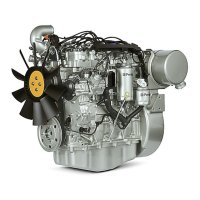• Never use compressed air for cleaning.
• Avoid brushing materials that contain asbestos.
• Avoid grinding materials that contain asbestos.
• Use a wet method in order to clean up asbestos
materials.
• A vacuum cleaner that is equipped with a high
efficiency particulate air filter (HEPA) can also be
used.
• Use exhaust ventilation on permanent machining
jobs.
• Wear an approved respirator if there is no other
way to control the dust.
• Comply with applicable rules and regulations for
the work place. In the United States , use
Occupational Safety and Health Administration
(OSHA) requirements. These OSHA
requirements can be found in 29 CFR 1910.1001.
• Obey environmental regulations for the disposal of
asbestos.
• Stay away from areas that might have asbestos
particles in the air.
Dispose of Waste Properly
Illustration 7 g00706404
Improperly disposing of waste can threaten the
environment. Potentially harmful fluids should be
disposed of according to local regulations.
Always use leakproof containers when you drain
fluids. Do not pour waste onto the ground, down a
drain, or into any source of water.
i04289958
Burn Prevention
Do not touch any part of an operating engine system.
The engine, the exhaust, and the engine
aftertreatmen
t system can reach temperatures as
high as 650 °C (1202 °F) under normal operating
conditions.
At idle engine
speed and/or zero vehicle speed, an
operator can request a manual regeneration. Under
this condition, the exhaust gas temperature can reach
650 °C (1202 °F). Otherwise automatic regeneration
can produce exhaust gas temperatures as high as
650 °C (1202 °F).
Allow the engine system to cool before any
maintenance is performed. Relieve all pressure in the
following systems, hydraulic system, lubrication
system, fuel system, and the cooling system before
related items are disconnected.
Contact with high pressure fuel may cause fluid
penetration and burn hazards. High pressure fuel
spray may cause a fire hazard. Failure to follow
these inspection, maintenance and service in-
structions may cause personal injury or death.
After the engine has stopped, you must wait for 10
minutes in order to allow the fuel pressure to be
purged from the high-pressure fuel lines before any
service or repair is performed on the engine fuel lines.
Induction System
Sulfuric Acid Burn Hazard may cause serious per-
sonal injury or death.
The exhaust gas cooler may contain a small
amount of sulfuric acid. The use of fuel with sulfur
levels greater than 15 ppm may increase the
amount of sulfuric acid formed. The sulfuric acid
may spill from the cooler during service of the en-
gine. The sulfuric acid will burn the eyes, skin and
clothing on contact. Always wear the appropriate
personal protective equipment (PPE) that is noted
on a material safety data sheet (MSDS) for sulfuric
acid. Always follow the directions for first aid that
are noted on a material safety data sheet (MSDS)
for sulfuric acid.
SEBU8726 9
Safety Section
Burn Prevention

